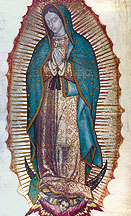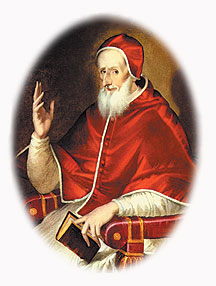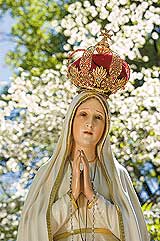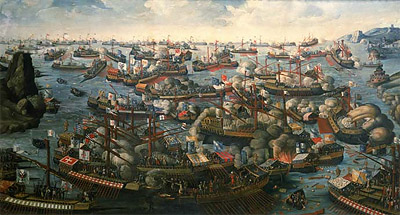The Intervention of Our Lady in History
Jeremias Wells
Just as in our daily lives we should always be cognizant of the presence of God, so in our analysis of historical events we should always keep in mind the power and intercession of the Blessed Virgin Mary over the sweep of history. In this series of studies titled Revolution and Counter-Revolution in History, we have recounted the decline in Western Civilization from the point where all human relations, institutions and even governments were permeated by the doctrines of the Church to our present situation that suffers under the influence of immorality, gross errors and atheism. Before we switch from the Western Hemisphere back to the European theater of operations, we should take the opportunity to illustrate Our Lady’s influence on historical events that is often sadly neglected.
Postscript to Cortes
Cortes had performed a prodigious military feat in subduing millions of Indians with only a few hundred soldiers and bringing Western Civilization to the American shores, but that alone would not have converted the Indians. After the intrepid commander had demolished the blood-soaked temples, he led an expedition to Honduras. Upon his return to Mexico City, he found political difficulties that required him to sail to Spain in 1528 and seek an audience with King Charles of Spain.
Numerous missionaries arrived in Mexico to open churches, schools and hospitals, but few Indians converted as paganism had struck deep roots in their soul. Moreover, the harsh treatment handed out by the earlier Spanish officials had turned them into a hostile, suspicious group. In order to heal the wounds of oppression, King Charles sent Bishop Zumarraga, a Franciscan prior, to protect the Indians from the insensitive officials who were subsequently recalled. But the damage was done and Zumarraga realized that a general uprising was imminent that would wipe out the Spanish presence in Central America. To avert the violent uprising, the kindly bishop prayed earnestly to Our Lady and asked her to send some Castilian roses as a sign that his prayers had been heard.
Cortes had performed a prodigious military feat in subduing millions of Indians with only a few hundred soldiers and bringing Western Civilization to the American shores, but that alone would not have converted the Indians. After the intrepid commander had demolished the blood-soaked temples, he led an expedition to Honduras. Upon his return to Mexico City, he found political difficulties that required him to sail to Spain in 1528 and seek an audience with King Charles of Spain.
Numerous missionaries arrived in Mexico to open churches, schools and hospitals, but few Indians converted as paganism had struck deep roots in their soul. Moreover, the harsh treatment handed out by the earlier Spanish officials had turned them into a hostile, suspicious group. In order to heal the wounds of oppression, King Charles sent Bishop Zumarraga, a Franciscan prior, to protect the Indians from the insensitive officials who were subsequently recalled. But the damage was done and Zumarraga realized that a general uprising was imminent that would wipe out the Spanish presence in Central America. To avert the violent uprising, the kindly bishop prayed earnestly to Our Lady and asked her to send some Castilian roses as a sign that his prayers had been heard.
 |
| The miraculous image of Our Lady of Guadalupe. Through Her intercession, an estimated nine million Indians converted in just a few years. |
In one of the most momentous events in all history, the Mother of God came down from Heaven and appeared to a humble Aztec peasant, Juan Diego, on a barren hill a few miles outside Mexico City. She identified herself by a word in Nahuatl, the Aztec language, as “She who crushes the serpent,” indicating that as the Immaculate Conception she will triumph over both the devil (Gen. 3:15) and one of the most terrible of all the Indian gods. Further corroboration is assured when one considers that the first apparition occurred on December 9, then the feast day of the Immaculate Conception.
She asked Juan Diego to go to Bishop Zumarraga and request that a church be built at the location of the first three visitations. Although he responded courteously, he showed some skepticism. His failure at the bishop’s palace and the imminent death of his beloved uncle threw Juan Diego into a state of confusion. When Our Lady appeared on December 12 to the Aztec peasant, this time at the bottom of the hill, she gave him the same message that she has been giving to her grieving children since that day: that she is the Mother of Mercy, of Life and of Hope to all who follow the teachings of her Son and have confidence in her powerful intercession.
To give credence to this loving power, the Blessed Virgin performed one of the most illustrious miracles in her wondrous repertoire that resonates across the world to this day. Following Our Lady’s instruction, Juan Diego climbed the hill known as Tepeyac to the location of the original apparitions where he found a field of brilliant, fragrant flowers including Castilian roses growing in frozen, rocky soil. He carefully gathered a bundle of the flowers in his cloak, which he used as an apron by holding the bottom to his chest, and went off to the bishop.
After he had been brought into the presence of the bishop, Juan Diego showed him the magnificent flowers. The prelate immediately fell to his knees and looked upon him with astounding amazement, for he saw imprinted on Juan Diego’s cloak an image of Our Lady as she had appeared that day. Bishop Zumarraga built a chapel to house the image with an adjoining room for Juan Diego at the miraculous site that, significantly, had been previously occupied by a pagan temple destroyed by Cortes. The miraculous circumstances and the inexplicable, powerful attraction of Our Lady’s image drew thousands of Aztecs to the shrine. Already converted in their hearts when they left, the pilgrims sought out missionaries for baptism, which brought about an avalanche of conversions across Central America, estimated to be about nine million after a few years.
Our Lady offered so many miraculous proofs of her loving guidance through the trials of this life that we only have space to recount a few. The cloak was woven from the hard fibers of the maguey cactus plant that normally has a life span of about twenty years before it decays. Over the years the fabric and image have been exposed to an exceptionally damp climate, incense and smoke from burning wax candles. Yet the fragile material and the delicate but rich coloration have withstood all the corrosive effects and millions of hands that have touched it. Also the lifelike expression of loving tenderness has remained undiminished.
Over the last few decades numerous scientists have examined the cloak or tilma and they have found that the image was produced by no known earthly substance, no paint, no printing materials, nothing. Its cause and existence is purely supernatural. One scientist using a powerful magnifying glass noticed that the face and shoulders of Juan Diego appeared in the pupil of the right eye. Further examination by two eye doctors with their ophthalmoscopes revealed the reflection of two other figures that were present in the bishop’s residence at the time of the miracle.
The ongoing combat between Our Lady and those who possess an unquenchable hatred for her and her influence reached a climax in 1921. A powerful time bomb placed by revolutionaries exploded just beneath the Sacred Image on the main altar of the Basilica of Guadalupe that ripped out huge chunks of marble and masonry. The heavy bronze altar cross was severely bent, yet the image of Our Blessed Mother was completely untouched. Moreover, the protective thin glass plate was not even scratched.
We are certainly implying a connection between Our Lady’s mediation in the conversion of the Aztecs from depraved human sacrificers and the necessity of her help in destroying today’s human sacrifice in abortion and immoral perversions and excesses. We can also make another connection between Our Lady of Guadalupe and her intercession at the Battle of Lepanto.
 |
| St. Pius V did what Catholics have always done in times of acute danger: fly into the arms of the most powerful Mother of God. |
Our Lady at Lepanto
When Saint Pius V ascended to Saint Peter’s throne, Christendom faced perils perhaps unequaled in its history of continual conflict, not the least of which came from the agitated and violent followers of Mohammed. All the information and intelligence that Pope Pius V had been gathering indicated that the Ottoman juggernaut was about to roll across the Mediterranean and adjacent lands, spearheaded by the Turkish fleet, with Italy and Rome as one of its targets. No nation could stand up to the marauding infidels and the candidates for an alliance were few. Northern Europe had risen up in armed rebellion against the Church with France deeply involved in the conflict. The Ottoman Empire felt that neutrality was the best policy after the Turks occupied a large chunk of its land in the Danube River Valley.
Only Spain and Venice had the resources to resist, and they hated each other along with deep mistrust. Yet Saint Pius — calling down divine grace as only a man of prayer could — forged an alliance with them as the core of an organized fleet of over 200 galleys. With his considerable tact and diplomatic skills, he not only kept them unified, but he convinced them to attack the enveloping menace. The details of the battle have been told previously (Crusade, July/Aug., 2005, chapter XV). Here we are only concerned with the influence of the supernatural element in the historical process.
The Archbishop of Mexico had an exact copy of the Holy Image of Guadalupe sent to King Philip II, who in turn gave it to Andrea Doria, one of the three principal admirals of the fleet, who placed it in his cabin. When the Armada went from file to line abreast and attacked on the morning of October 7, the blue standard of Our Lady of Guadalupe was also flying from the masthead of Don Juan’s flagship. But Our Lady’s presence that day was more acutely felt through the Holy Rosary.
Our Lady of the Rosary
Pope Pius V, a Dominican prelate before his elevation, did what Catholics have always done in times of acute danger: fly into the arms of the most powerful Mother of God. As a follower of Saint Dominic, he knew the most effective means of imploring her help was through the recitation of the Holy Rosary. He ordered all monasteries and convents in Rome to increase their prayers for the impending battle and organized rosary processions in which he, as sick as he was, participated.
As the Christian fleet sailed toward the great clash of cultures, Mass was celebrated and the rosary recited daily on each vessel. This heartfelt request for divine assistance resulted in a crushing defeat of the Ottomans at Lepanto that ended their dominance in the Mediterranean.
To celebrate Our Lady’s intercession, the Church has designated October 7 as the Feast of the Holy Rosary and Saint Pius V added Help of Christians (Auxilium Christianorum) to the Litany of Our Lady (Loreto). Similar acknowledgement to the Blessed Virgin’s intercession through the rosary were made when John Sobieski forced the Turks to lift the Siege of Vienna in 1683 and after the victory of Prince Eugene of Savoy at Temesvar in his successful campaign to remove the Ottomans from Europe in the next century.
While the din of battle gradually diminished at the bloody waters off Lepanto, Saint Pius V was going over accounts in the papal apartments with Bartolo Busotti, his treasurer. Suddenly, he arose with his face radiant with joy and announced, “Let us go and thank God, for this moment our fleet has defeated the Turks.” Human agency brought news to Rome two weeks later.
 |
| As Our Lady predicted at Fatima, Portugal, She will intervene again in history as She did in Mexico and Lepanto. |
Some may object to the historical paradigm, not that it is inappropriate, but that it happened a long time ago. Yet, the Blessed Virgin made another historical visit to earth just ninety years ago, bringing roughly the same message to a larger distressed population. As Our Lady of the Rosary, she appeared six times at Fatima in Portugal to three related children, two of whom have been recently beatified. Our publications have probably given more space to this story than any other. Here we would like to stress the historical applications.
In essence, she warned that God was terribly offended by the sins of mankind and unless that sinfulness subsided the world as a consequence would face horrible chastisements. Immediately following, we had a bloody conclusion to World War I, then six years of the most depraved slaughter of World War II and continual wars, atrocities and mutilations ever since instigated by two of the enemies of Western Civilization: Communism (as Our Lady predicted) and Islam. Sinfulness has not abated, but only increased, especially in the areas of family life, immoral fashions and lewd entertainment.
Our Lady will intervene once again in history, either to help her suffering children who have recourse to her or to bring down the wrath of God on those who refuse to pray, make sacrifices and stop offending Him. During the third apparition she announced the ultimate result, “Finally my Immaculate Heart will triumph!”
Woman Clothed with the Sun

